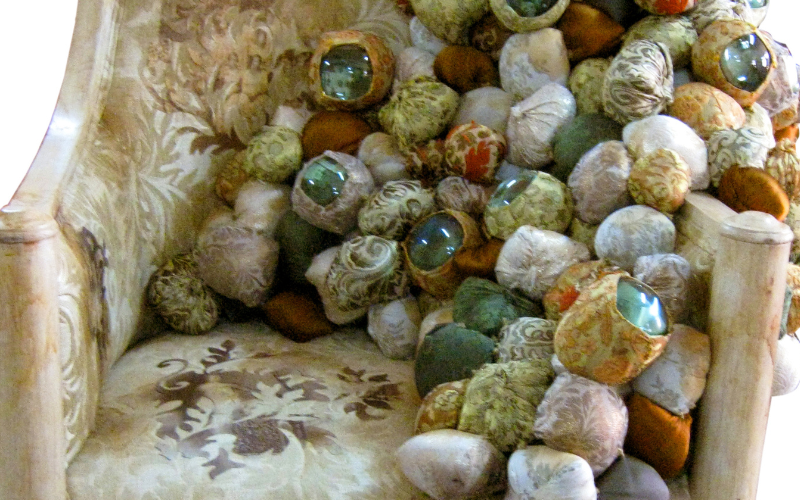Shilpa Gupta is a Mumbai-based artist whose works reckon with questions of identity, power-structures, and perceptions of world order. As a student at the Sir JJ School of Art in the 1990s, she witnessed the Bombay riots that exposed the prevalent sectarianism in post-partitioned India, challenging the cosmopolitan ideals that she was raised with in the city. Stemming from this disillusioning moment, and her experiences at sensitive-border regions in Kashmir and Bengal, Gupta’s artworks respond to the boundaries, signposts, texts, or labels that codifypeople, places, and objects. By exploring how constricting structures might be expanded or transgressed, she intimately probes universal concerns surrounding freedom, security, and collective memory.
In an early 1995-96 work, Gupta posted 300 ink-drawings anonymously to people in her city. Each drawing was stamped and numbered, situating it in relation to those preceding and succeeding it, to make participants consider notions of belongingness, authenticity, and time. Entrenched in negotiations of chance, mobility, and fluidity, as well as the politics of naming and assigning value to things, the work set the tone for ideas she investigates across her practice. In a subsequent work, Untitled (Prove that you care) (1997), she invited visitors to create personal memory boxes of their loved ones through bodily remnants and unclaimed everyday items, confounding conceptions of attachment, memory, and the archive. The work deliberated how memories may be assorted through objects that are ostensibly generic but laden with subjective associations. Gupta is renowned for deftly transforming the mundane into conceptual artworks that scrutinise the human experience and subvert premises of conflict.
Her participatory works make audiences think critically about social behaviour. For instance, in 2000, Gupta filled bottles, labelled Blame with simulated blood that she peddled on commuter trains, posing as a salesperson. She challenged mechanisms that inculpate those considered ‘other’ by asking people to perform the impossible task of separating the ingredients within the bottle based on markers such as religion or nationality. In a 2007 exhibition in London, she covered bags in fabrics marked with the text “There is No Explosive in this.” Visitors were encouraged to carry these into public spaces, confronting suspicious gazes and discerning how societal anxieties are constructed. In a 2008-9 exhibition featuring a sculpture consisting of 2,400 bars of soap, each engraved with the word Threat, she invited participants to take a bar away, negotiating how fear, a manipulative tool, could be dismantled or washed away.
Gupta’s works frequently respond to the apathy and abuse of power that the State demonstrates towards those who speak up during political unrest —by not only obliterating them physically, but also from public records. In her seminal 2006 installation, Untitled (Wives of the Disappeared), viewers waded through a sea of suspended garments belonging to victims of insurgencies in Kashmir. These garments featured numbers stitched on them, representing those registered officially as well as known unofficially, as dead or missing. The clothes were exaggerated to account for the possible conditions in which the missing might return — amputated, with overgrown limbs, scarred, or dead. The work also featured a video of woman, Gupta herself, holding a flag to commemorate the deceased. Continuing her explorations of performativity, while condemning politically-controlled media that dictate perceptions of reality, Gupta also employs bureaucratic apparatus to magnify silenced issues. Singing Cloud (2008-9), an amorphous hanging sculpture composed of thousands of microphones amplified the voices of those that rise up against the landscapes of fear, cultivated through systems of control that cement divides between people.
Highlighting the futility of political divisions, Gupta’s works often juxtapose ideas of empirical measurement used to construct border lines, against ground reality. In 100 Hand Drawn Maps of India (2008-9), she asked people to draw maps of their countries, revealing how each person remembers the shape differently. Contrasting this incongruence, 1:14.9 (2011-12), at the Solomon R. Guggenheim Museum, New York, features a neat ball of thread that she wound at a fixed ratio to ironically signify the mathematically-constructed fenced border between India and Pakistan. In a similar vein, her 2015 installation as part of her celebrated My East is Your West exhibition in Venice, featureda performer drawing lines on a piece of cloth, proportionate in length to a newly proposed Indo-Bangladesh border. Challenging arbitrary boundaries continuously,Gupta’s text-based work, There is No Border Here (2005-6), exhibited around the world, emphasises the absurdity of political lines in light of shared elements like the sky.
Poetic texts, ideas surrounding the politics of language, and notions of illegibility recur in Gupta’s works. In a public installation in Mumbai, she represented her titular text, I live under your sky too (2004 - ongoing), in English, Urdu, and Hindi. Her interest in the power of the written word is evidenced most profoundly in In Your Tongue, I Cannot Fit (2018), an installation displayed at the Kochi-Muziris Biennale (2018-19) and the Venice Biennale (2019). The work gave voice to 100 poets from around the world who were imprisoned for their principles, to emphasise the tenuousness of the freedom of expression and the valour of those who resist.
Gupta’s second installation, Untitled (2008-09), at the Venice Biennale featured a mechanical gate, swinging back and forth aggressively to eventually crack and break the wall it was installed against. Vigorously expressing the need to shatter ideological confines, the work succinctly encapsulated Gupta’s practice that remains poetic, even as she transforms commonplace situations into provocative gestures. She reminds us to recognise the structures that manoeuvre our lives.
The artist lives and works in Mumbai, India.

We use cookies to improve your experience. By navigating the site, you agree to our Cookie Policy.

